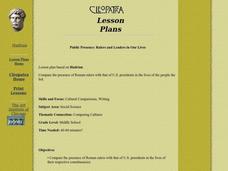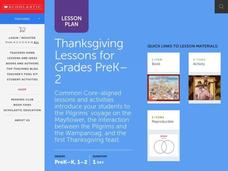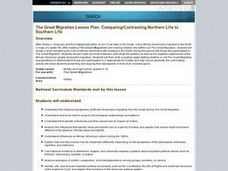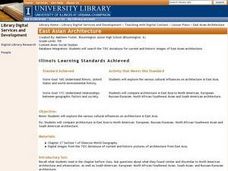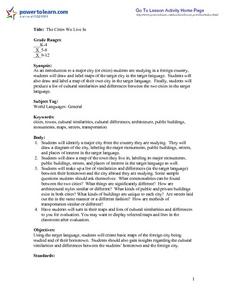Curated OER
Coin Art 4-6
Students study the historical figures and symbols of U.S.
patriotism depicted on the penny, nickel, dime, and quarter coins and learn that artists designed the portraits and other images on the coins. They research Texas symbols and...
Curated OER
Altoona Horseshoe Curve: A Vital Link
Students explain the significance of the Horseshoe Curve. For this railroad instructional activity students reconstruct elements of a German plot to destroy the Horseshoe Curve.
Curated OER
Comparing Modern and Ancient Rome VENN Diagram
In this modern and ancient Rome worksheet, students use a Venn diagram to compare the cultures and details of Rome today versus in the ancient past.
Curated OER
Public Presence: Rulers and Leaders in Our Lives
Students compare the presence of Roman rulers with that of U.S. presidents in the lives of the people the led. They complete a worksheet imbedded in this lesson plan.
Curated OER
200 Greatest Pop Culture Icons
Students discuss style and characteristics of musical time periods as well as the definition of "pop culture." They compare and contrast modern-day popular icons to music icons throughout history. This lesson requires a video,...
Scholastic
Thanksgiving Lessons Grades PreK-2
A quintessential resource for teaching an elementary unit on the first Thanksgiving addresses a variety of skills, including informational reading, critical thinking, comparing and contrasting facts, technology tools, and historical...
Curated OER
200 Greatest Pop Culture Icons
Students discuss the style and characteristics of the Classical era and the genre of opera. They compare and contrast modern day popular icons to musical icons throughout history. They write original librettos to modern entertainment.
Curated OER
Different Ways We Celebrate
Students examine a variety of ways that families celebrate winter holidays. They complete a graphic organizer comparing Christmas, Hanukkah, and Kwanzaa, and write a five-sentence paragraph about one of the holidays discussed. Students...
Curated OER
From Greece to Main Street
Students consider the influence of the Greeks on American architecture. In this American Greek Revival architecture lesson, students identify the attributes of architectural style as they compare the Parthenon with the Lincoln Memorial....
Curated OER
2.0 "Water Is Life" Global Water Awareness Mini-Unit (Grades3-5)
Students study the amount of potable water on the Earth. In this water lesson, students examine the amount of potable water as compared to all the water on the Earth. They discuss why many parts of the world do not have access to good...
Curated OER
Comparing/Contrasting Northern Life to Southern Life
Students compare and contrast the lives of African Americans who moved North vs. those who stayed in the South during the era of Jim Crow Laws.
Curated OER
Supporting Opinions - Ken from Japan
Middle schoolers write a compare and contrast essay. In this writing skills lesson, students learn about life in Japan through a video of a Japanese third grader. Middle schoolers use notes written on the video to write a...
Curated OER
Revolutionary Women of South Carolina
Students examine multiple primary sources. For this revolutionary war lesson, students read case studies regarding women from South Carolina. Students will compare the different roles women played during the Revolutionary War. Students...
Curated OER
Minoan Paintings
In this art worksheet, students look at some pictures given of Minoan paintings. They describe the type of clothing worn by the Minoans, how they wore their hair, what their skin color was, and what colors seemed to be favored in the...
Curated OER
European Architecture
Seventh graders search online for current and historic images of European architecture. They compare current European architecture to North American, and South American architecture.
Curated OER
Russian and Eurasian Architecture
Seventh graders search online for current and historic images of Russian and Eurasian architecture. They compare current Russian and Eurasian architecture to North American, European, and South American architecture.
Curated OER
living in our family
Students compare a day in the life of a young person in one Asian country (India, Indonesia, Philippines, Thailand, or Vietnam) with a day in their own lives. The focus of this unit of work is on families, and students are required to...
Curated OER
East Asian Architecture
Seventh graders compare architecture in East Asia to North American, European, Russian/Eurasian, North African/Southwest Asian and South American architecture. They search the internet for current and historic images of East Asian...
Curated OER
North African and Southwest Asian Architecture
Seventh graders search online for current and historic images of North African and Southwest Asian architecture. They compare North African and Southwest Asian architecture to North American, European, Russian/Eurasian, and South...
Curated OER
Southeast Asian Architecture
Seventh graders search online for current and historic images of Southeast Asian architecture. They compare architecture in Southeast Asia to North American, European, Russian/Eurasian, North African/Southwest Asian and South American...
Curated OER
Someone Is In The Kitchen
Students investigate the lifestyles of the Native Americans and look at a recipe found on a website. They read the recipe and pay attention to the measurements. They differentiate between the various measures in order to apply them to...
Curated OER
The Cities We Live In
Students research a major city. They create a diagram of the city, labeling major monuments and points of interest. Next, students draw a map of their own town and label its major interest areas. Students compare and contrast their...
Curated OER
Centennial: A Day In The Life Of Children - Then And Now
Fourth graders compare and contrast the rules and responsibilities of children from today and in the past. In groups, they compare and contrast their daily lives with a child in history. After taking a field trip, they discuss how...
Curated OER
Warlugulong
Students explore and appreciate variety of ways in which environment can be depicted for range of purposes. They compare different representations of place and environment, and analyze ways information is being communicated.



